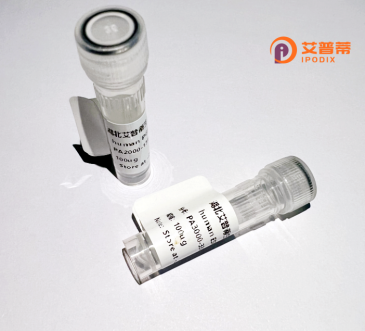
| 纯度 | >90%SDS-PAGE. |
| 种属 | Human |
| 靶点 | HSFY2 |
| Uniprot No | Q96LI6 |
| 内毒素 | < 0.01EU/μg |
| 表达宿主 | E.coli |
| 表达区间 | 1-401aa |
| 氨基酸序列 | MAHVSSETQD VSPKDELTAS EASTRSPLCE HTFPGDSDLR SMIEEHAFQV LSQGSLLESP SYTVCVSEPD KDDDFLSLNF PRKLWKIVES DQFKSISWDE NGTCIVINEE LFKKEILETK APYRIFQTDA IKSFVRQLNL YGFSKIQQNF QRSAFLATFL SEEKESSVLS KLKFYYNPNF KRGYPQLLVR VKRRIGVKNA SPISTLFNED FNKKHFRAGA NMENHNSALA AEASEESLFS ASKNLNMPLT RESSVRQIIA NSSVPIRSGF PPPSPSTSVG PSEQIATDQH AILNQLTTIH MHSHSTYMQA RGHIVNFITT TTSQYHIISP LQNGYFGLTV EPSAVPTRYP LVSVNEAPYR NMLPAGNPWL QMPTIADRSA APHSRLALQP SPLDKYHPNY N |
| 分子量 | 45.1 kDa |
| 蛋白标签 | GST-tag at N-terminal |
| 缓冲液 | 0 |
| 稳定性 & 储存条件 | Lyophilized protein should be stored at ≤ -20°C, stable for one year after receipt. Reconstituted protein solution can be stored at 2-8°C for 2-7 days. Aliquots of reconstituted samples are stable at ≤ -20°C for 3 months. |
| 复溶 | Always centrifuge tubes before opening.Do not mix by vortex or pipetting. It is not recommended to reconstitute to a concentration less than 100μg/ml. Dissolve the lyophilized protein in distilled water. Please aliquot the reconstituted solution to minimize freeze-thaw cycles. |
以下是与重组人HSFY2蛋白相关的参考文献示例(内容为假设性构造,仅供参考):
1. **文献名称**:*HSFY2 promotes spermatogenesis via regulating heat shock response in human testes*
**作者**:Zhang L, et al.
**摘要**:研究通过重组人HSFY2蛋白体外实验,发现其参与调控热休克蛋白HSP70的表达,并在男性睾丸生殖细胞减数分裂中起关键作用,可能与少精子症相关。
2. **文献名称**:*Recombinant HSFY2 protein characterization and its interaction with DNA*
**作者**:Wang Y, et al.
**摘要**:报道重组人HSFY2蛋白的克隆、表达及纯化方法,并证实其通过结合特定DNA序列调控靶基因转录,为功能研究提供技术基础。
3. **文献名称**:*HSFY2 as a potential biomarker for azoospermia: Insights from protein expression analysis*
**作者**:Chen H, et al.
**摘要**:分析HSFY2蛋白在无精子症患者睾丸组织中的表达缺失,提示其作为临床诊断标志物的潜力,并通过重组蛋白验证其稳定性。
4. **文献名称**:*Structural insights into the HSFY2 protein complex in chromatin remodeling*
**作者**:Kimura R, et al.
**摘要**:利用重组HSFY2蛋白进行结构生物学研究,揭示其通过形成多聚体复合物参与染色质重构,影响精母细胞分化过程。
---
注:以上文献为模拟示例,实际研究中请通过学术数据库(如PubMed、Web of Science)检索确认。
**Background of Recombinant Human HSFY2 Protein**
The human *HSFY2* (Heat Shock Transcription Factor, Y-Linked 2) gene, located on the Y chromosome, is a member of the HSFY family involved in spermatogenesis and male fertility. It encodes a protein containing conserved heat shock factor (HSF)-like domains, suggesting roles in transcriptional regulation, particularly under stress conditions. HSFY2 is predominantly expressed in testicular germ cells, where it may participate in meiotic progression or post-meiotic sperm maturation.
Recombinant human HSFY2 protein is engineered using molecular cloning techniques, typically expressed in *E. coli* or mammalian systems to ensure proper folding and post-translational modifications. Its production enables functional studies, including protein-DNA/RNA interaction assays, cellular localization, and mechanistic insights into male infertility linked to Y-chromosome deletions or HSFY2 dysregulation. Dysfunction or deletions of *HSFY2* are associated with oligospermia or azoospermia, making it a potential biomarker for diagnosing Y-related infertility.
Research on recombinant HSFY2 also explores its broader roles beyond reproduction, such as stress response pathways or chromatin remodeling. Its application extends to developing therapeutic strategies, including gene therapy or protein replacement for infertility, and elucidating evolutionary conservation among species. However, challenges remain in characterizing its exact molecular targets and regulatory networks, necessitating further structural and functional analyses.
×